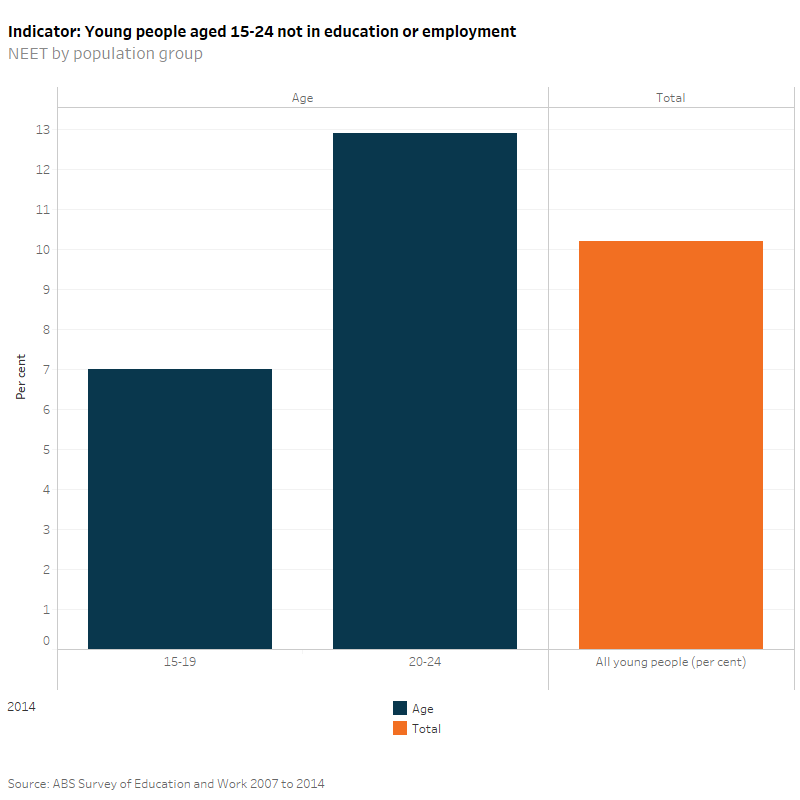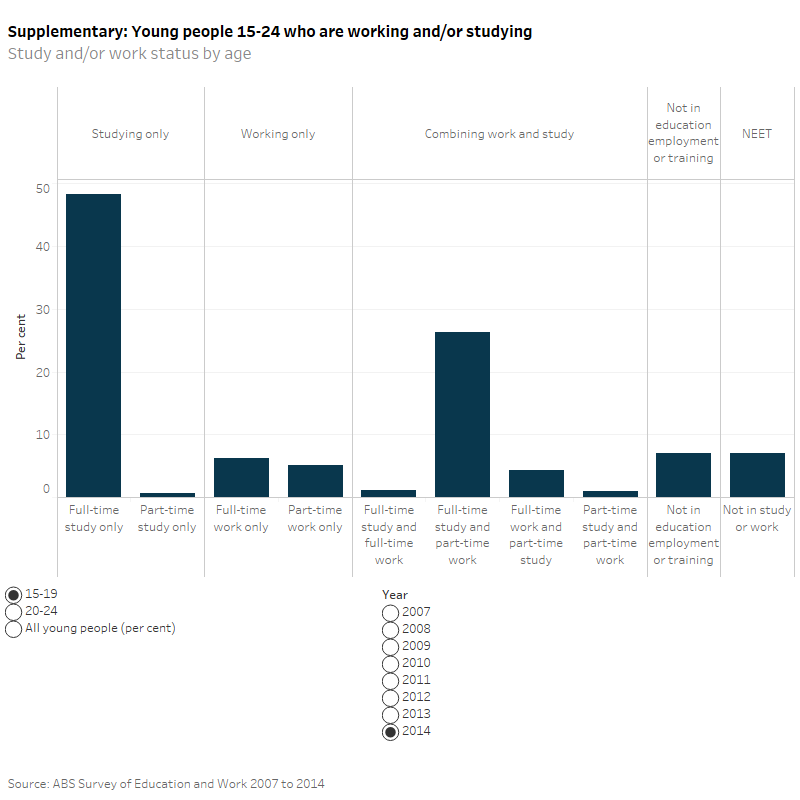Not in education or employment, or training (NEET)
Why are NEET rates important?
Young people who are not in education, employment or training are often referred to as ‘NEET’ and regarded as disengaged from work and study. The proportion of young people in the NEET population can be regarded as an indicator of the smoothness of transition from education to work (NCVER: Stanwick et al. 2014).
While being part of the NEET population may indicate an intended break in the pathway from school to work, it can also reflect a mismatch between the skills of young people and the skills required by the labour market (OECD 2014), and/or a difficult labour market. Young people in the NEET population are at risk of becoming socially excluded, with income below the poverty line and without the skills to improve their economic situation (OECD 2014).
Do NEET rates vary across population groups?
In 2014, according to the ABS Survey of Education and Work, 10% of 15–24 years olds were part of the NEET population (7.0% of 15–19 year olds and 13% of 20–24 year olds).
Based on the 2011 Census, Indigenous young people aged 15-24 were 3 times as likely (31%) to be part of the NEET population compared with non-Indigenous young people (9.2%).
Young people who did not speak English well or at all were more than twice as likely to be in the NEET population compared with those who spoke English well (8.6%).
Young people needing assistance with core activities (such as self-care, body movements or communication) were more than 3 times as likely (35%) to be in the NEET population compared with those who did not need assistance (9.6%).
The proportion of young people in the NEET population rose with increasing remoteness, from 8.4% in major cities to 11.8% in inner regional areas, and 22% in remote and very remote areas.
Has there been a change over time?
Between 2007 and 2014, the proportion of the NEET population aged 15–24 years remained relatively stable (9.1% in 2007 and 10.2% in 2014). For those aged 20–24 there was a statistically significant increase in the NEET population from 11.1% to 12.9% between 2007 and 2014.


*This report is based on survey data; relative standard errors and 95% confidence intervals are provided in the Source data tables: NYIF indicators. Some estimates have relative standard errors of 25% to 50% and should be used with caution. Significance testing was undertaken on values cited in the text; unless otherwise stated, differences were found to be statistically significant.
Young people aged 15–17 may be more likely to participate in education, training or employment due to the mandatory National Youth Participation Requirement, agreed by the Council of Australian Governments (COAG) and introduced in 2010, which requires all young people to participate in schooling until they complete Year 10, and to participate in full-time education, training or employment (or a combination of these) until the age of 17 (COAG 2009). Future updates of this data portal will report on young people aged 18-24 year olds.
The NEET population includes both those who are unemployed but looking for work, and those considered ‘not in the labour force’ or NILF. Those who are not in the labour force may be undertaking home duties and/or looking after children, travelling or on holidays, or taking other ‘unspecified’ activities (Stanwick et al. 2013).
Prior to the introduction of the National Youth Participation Requirement in 2010, the minimum school leaving age in many jurisdictions was 15 or 16.
ABS Survey of Education and Work 2007 to 2014; ABS Census of Population and Housing, 2011
Data quality statement: ABS Survey of Education and Work 2014
COAG (Council of Australian Governments) 2009. Council of Australian Governments Meeting Hobart 30 April 2009 Communique. Accessed 22 May 2015.
NCVER (National Centre for Vocational Education Research): Stanwick J, Lu T, Rittie T & Circelli M 2014. How young people are faring in the transition from school to work. Foundation for Young Australians. Viewed 26 July 2015.
OECD (Organisation for Economic Co-operation and Development) 2014. Education at a glance 2014: OECD Indicators. OECD Publishing.
Stanwick J, Ju T, Karmel T & Wibrow B 2013. How young people are faring 2013: the national report on the learning and earning of young Australians. Melbourne: Foundation for Young Australians.


